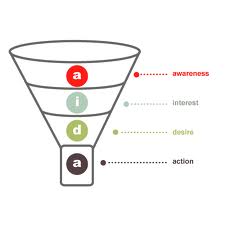 Awareness. Interest, Desire. Action. When I took my first advertising course almost thirty years ago, our professor intoned those words as if they were gospel. “That is how,” he would say, “consumers move along the path to purchasing this item or that one.” And the whole industry was built around that never-proven, not-based-on-any-credible-research theory — all the stuff about reach and frequency and three-exposures-required-to-gain-awareness. It was how plans were developed, how fortunes made (and spent). AIDA.
Awareness. Interest, Desire. Action. When I took my first advertising course almost thirty years ago, our professor intoned those words as if they were gospel. “That is how,” he would say, “consumers move along the path to purchasing this item or that one.” And the whole industry was built around that never-proven, not-based-on-any-credible-research theory — all the stuff about reach and frequency and three-exposures-required-to-gain-awareness. It was how plans were developed, how fortunes made (and spent). AIDA.
For over 20 years now, since the advent of integrated marketing communications, the AIDA theory has been on the wane. Customers just aren’t that simple. The most current research by McKinsey about the Consumer Decision Journey should have put it to rest forever. And yet,… and yet students and clients still talk to me about AIDA as if it were the latest thing, as if all we have to do is make enough people aware of a brand to magically induce some portion of them to take interest, a smaller portion to develop desire, and a smaller portion yet to take action and buy: simply pour enough people into the top of the funnel (awareness) to see some flow out the bottom (action). Once upon a time, the P & Gs of the world placed product on every shelf and could buy enough reach and frequency for a product to make it look as if awareness led inexorably to action. Maybe it was even true in some small way. But not anymore. And even if it were, with people’s attention divided between so many media, so many content offerings, who can afford to buy huge awareness anymore?
The newer models, including McKinsey’s and inbound marketing models, take into account — correctly — the fact that interest now often precedes awareness. People start with a set of acceptable brands, search for information, stumble upon things they weren’t hunting for, develop a modified set of acceptable brands, search some more, succumb to last minute changes of heart — in short, they act like people, not like lab rats. A brand’s mere presence somewhere on the journey, combined with the ability to establish some sort of connection, based on shared goals, values, or interest — as opposed to a simple bludgeoning of customers with a blunt message — can win the day. Let’s call it “affinity,” rather than “awareness,” that drives the brand decision journey.
Oddly enough, traditional media — notably television — can be effective in developing affinity, because of its great story-telling power, even though it lacks interactivity (for the time being), while most Internet advertising fails horribly in this regard. I urge you to check out two great pieces about this: a blog post by David Aaker and a video of a tremendous TED presentation by Chris Anderson. One of the key nuggets of knowledge that drives them both is the fact that the advertising value of an hour of an Internet user’s time is only about a dime. The reason is not only because the Internet’s infinite inventory of advertising makes it very cheap, but because we have not yet cracked the code on how to make it effective, that is engage people and drive affinity. Most of us are still caught up in the AIDA model — impressions, eyeballs, clicks.
This is partially a measurement problem. Impressions, clicks and the like are very measurable; affinity and connection not so much. But we are also faced with a creativity problem. Knowing what we know about how individual customers make decisions, understanding that they are now in charge of what they see and when they see it, how do we use all the available new platforms to enable them to meet and engage with brands on their own terms? In a world where advertising is more like wildflowers and less like bullets, how do we spread our messages?
Social media has blossomed as a brandland strategy in response to this dilemma. But it’s only one answer. What seems clear while we grope to use digital and traditional media more effectively is that building brand communications around a full understanding of individuals’ complex motivations and habits, rather than forcing messages down any available throats, seems a better prescription for long-term brand health.

